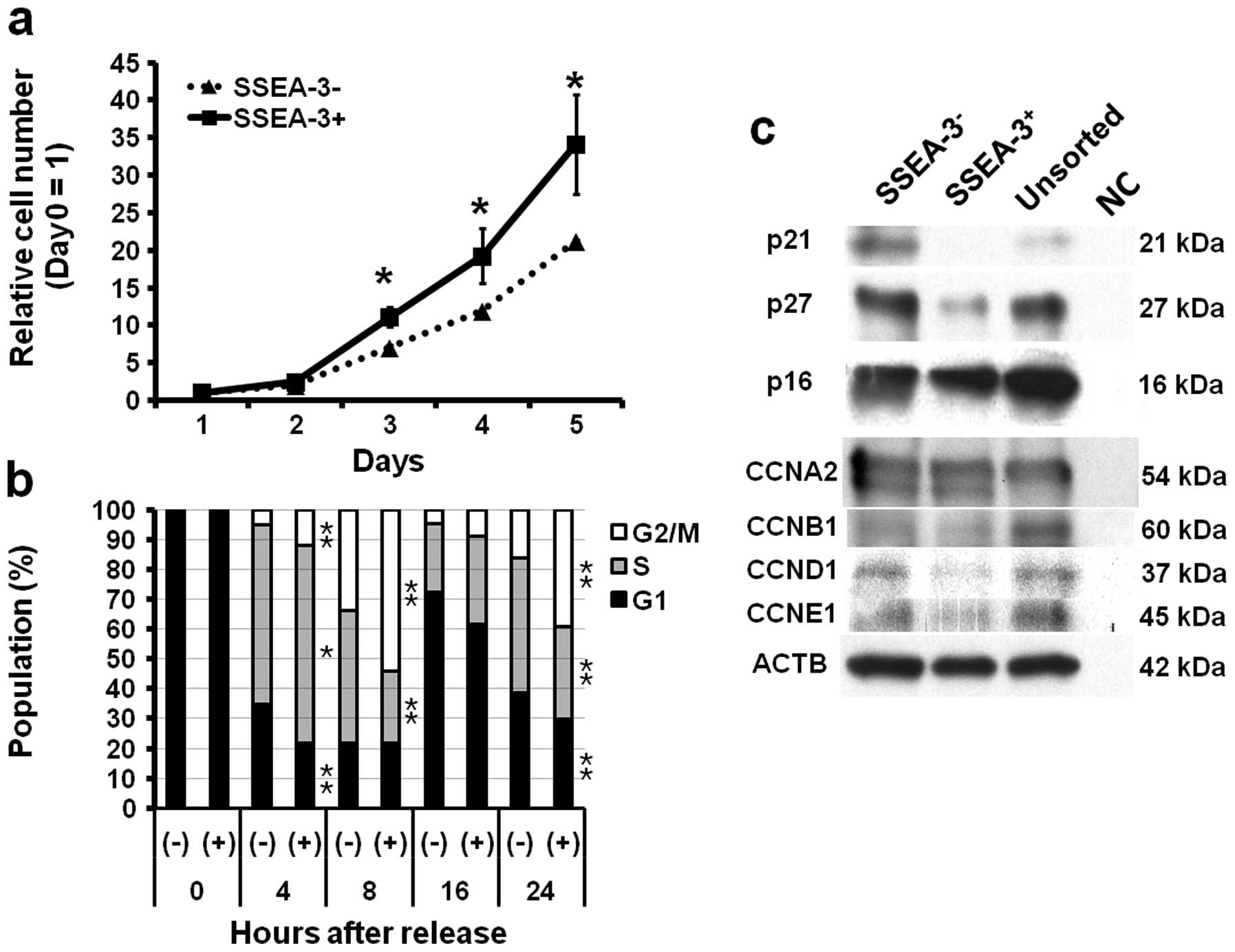|
1.
|
Ben-Porath I, Thomson MW, Carey VJ, et al:
An embryonic stem cell-like gene expression signature in poorly
differentiated aggressive human tumors. Nat Genet. 40:499–507.
2008.
|
|
2.
|
Levina V, Marrangoni AM, DeMarco R,
Gorelik E and Lokshin AE: Drug-selected human lung cancer stem
cells: cytokine network, tumorigenic and metastatic properties.
PLoS One. 3:E30772008.
|
|
3.
|
Rajasekhar VK, Studer L, Gerald W, Socci
ND and Scher HI: Tumour-initiating stem-like cells in human
prostate cancer exhibit increased NF-kappaB signalling. Nat Commun.
2:1622011.
|
|
4.
|
Wright AJ and Andrews PW: Surface marker
antigens in the characterization of human embryonic stem cells.
Stem Cell Res. 3:3–11. 2009.
|
|
5.
|
Solter D and Knowles BB: Monoclonal
antibody defining a stage-specific mouse embryonic antigen
(SSEA-1). Proc Natl Acad Sci USA. 75:5565–5569. 1978.
|
|
6.
|
Shevinsky LH, Knowles BB, Damjanov I and
Solter D: Monoclonal antibody to murine embryos defines a
stage-specific embryonic antigen expressed on mouse embryos and
human teratocarcinoma cells. Cell. 30:697–705. 1982.
|
|
7.
|
Kannagi R, Cochran NA, Ishigami F, et al:
Stage-specific embryonic antigens (SSEA-3 and -4) are epitopes of a
unique globo-series ganglioside isolated from human teratocarcinoma
cells. EMBO J. 2:2355–2361. 1983.
|
|
8.
|
Solter D, Shevinsky L, Knowles BB and
Strickland S: The induction of antigenic changes in a
teratocarcinoma stem cell line (F9) by retinoic acid. Dev Biol.
70:515–521. 1979.
|
|
9.
|
Evans MJ and Kaufman MH: Establishment in
culture of pluri-potential cells from mouse embryos. Nature.
292:154–156. 1981.
|
|
10.
|
Takahashi K and Yamanaka S: Induction of
pluripotent stem cells from mouse embryonic and adult fibroblast
cultures by defined factors. Cell. 126:663–676. 2006.
|
|
11.
|
Thomson JA, Itskovitz-Eldor J, Shapiro SS,
et al: Embryonic stem cell lines derived from human blastocysts.
Science. 282:1145–1147. 1998.
|
|
12.
|
Takahashi K, Tanabe K, Ohnuki M, et al:
Induction of pluripotent stem cells from adult human fibroblasts by
defined factors. Cell. 131:861–872. 2007.
|
|
13.
|
Kuroda Y, Kitada M, Wakao S, et al: Unique
multipotent cells in adult human mesenchymal cell populations. Proc
Natl Acad Sci USA. 107:8639–8643. 2010.
|
|
14.
|
Kannagi R: Carbohydrate-mediated cell
adhesion involved in hematogenous metastasis of cancer. Glycoconj
J. 14:577–584. 1997.
|
|
15.
|
Son MJ, Woolard K, Nam DH, Lee J and Fine
HA: SSEA-1 is an enrichment marker for tumor-initiating cells in
human glioblastoma. Cell Stem Cell. 4:440–452. 2009.
|
|
16.
|
Ye F, Li Y, Hu Y, Zhou C and Chen H:
Stage-specific embryonic antigen 4 expression in epithelial ovarian
carcinoma. Int J Gynecol Cancer. 20:958–964. 2010.
|
|
17.
|
Chang WW, Lee CH, Lee P, et al: Expression
of Globo H and SSEA3 in breast cancer stem cells and the
involvement of fucosyl transferases 1 and 2 in Globo H synthesis.
Proc Natl Acad Sci USA. 105:11667–11672. 2008.
|
|
18.
|
Yamamoto H, Kondo M, Nakamori S, et al:
JTE-522, a cyclooxygenase-2 inhibitor, is an effective
chemopreventive agent against rat experimental liver fibrosis1.
Gastroenterology. 125:556–571. 2003.
|
|
19.
|
Bello LJ: Studies on gene activity in
synchronized culture of mammalian cells. Biochim Biophys Acta.
179:204–213. 1969.
|
|
20.
|
Wilker EW, van Vugt MA, Artim SA, et al:
14-3-3sigma controls mitotic translation to facilitate cytokinesis.
Nature. 446:329–332. 2007.
|
|
21.
|
Ware JL and DeLong ER: Influence of tumour
size on human prostate tumour metastasis in athymic nude mice. Br J
Cancer. 51:419–423. 1985.
|
|
22.
|
Todaro M, Francipane MG, Medema JP and
Stassi G: Colon cancer stem cells: promise of targeted therapy.
Gastroenterology. 138:2151–2162. 2010.
|
|
23.
|
Wakao S, Kitada M, Kuroda Y, et al:
Multilineage-differentiating stress-enduring (Muse) cells are a
primary source of induced pluripotent stem cells in human
fibroblasts. Proc Natl Acad Sci USA. 108:9875–9880. 2011.
|
|
24.
|
Stewart MH, Bosse M, Chadwick K, Menendez
P, Bendall SC and Bhatia M: Clonal isolation of hESCs reveals
heterogeneity within the pluripotent stem cell compartment. Nat
Methods. 3:807–815. 2006.
|
|
25.
|
Yeung TM, Gandhi SC, Wilding JL, Muschel R
and Bodmer WF: Cancer stem cells from colorectal cancer-derived
cell lines. Proc Natl Acad Sci USA. 107:3722–3727. 2010.
|
|
26.
|
Dieter SM, Ball CR, Hoffmann CM, et al:
Distinct types of tumor-initiating cells form human colon cancer
tumors and metastases. Cell Stem Cell. 9:357–365. 2011.
|
|
27.
|
Wander SA, Zhao D and Slingerland JM: p27:
a barometer of signaling deregulation and potential predictor of
response to targeted therapies. Clin Cancer Res. 17:12–18.
2011.
|
|
28.
|
Baldassarre G, Barone MV, Belletti B, et
al: Key role of the cyclin-dependent kinase inhibitor p27kip1 for
embryonal carcinoma cell survival and differentiation. Oncogene.
18:6241–6251. 1999.
|
|
29.
|
Niculescu AB III, Chen X, Smeets M, Hengst
L, Prives C and Reed SI: Effects of p21(Cip1/Waf1) at both the G1/S
and the G2/M cell cycle transitions: pRb is a critical determinant
in blocking DNA replication and in preventing endoreduplication.
Mol Cell Biol. 18:629–643. 1998.
|













